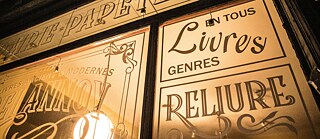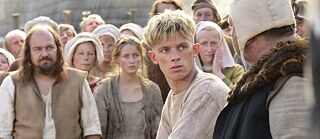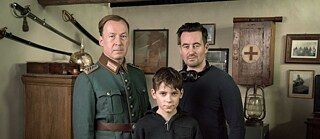Screen adaptations of literature
Grey clouds sweeping across the sea

Novels have been made into films ever since cinema came into existence. Three very different literary adaptations celebrated their premiere shortly before the Corona crisis – “Deutschstunde” (The German Lesson), “Narcissus und Goldmund” (Narcissus and Goldmund) and “Als Hitler das rosa Kaninchen stahl” (When Hitler Stole Pink Rabbit).
By Matthias Bischoff
Screen adaptations are always a challenge. Is it really possible to depict the images that many readers have in their heads in film visualisations? All too often only the external course of action makes it into the film. The more demanding, refined and allusive the original literary source is, the greater the risk of failure. A striking example of this is the film adaptation of the novel Narcissus and Goldmund by Hermann Hesse, the making of which involved considerable expense and effort. The book from 1930 tells in legendary language the life of two very different friends who first meet in a medieval monastery. Narcissus (Sabin Tambrea) stands for the rationally cerebral entity, the intellectual, while Goldmund (Jannis Niewöhner) strives to live life to the full, embodying sensuality and acting on his gut feelings. Accordingly, he is the one who, after spending their formative years together, leaves the monastery to go out into the world. He becomes a sculptor’s master apprentice, has numerous love affairs and becomes completely absorbed in his worldly existence. Narcissus, on the other hand, remains in the manageable world of the monastery.

Lost in “The German Lesson”
The new film adaptation of Siegfried Lenz’s post-war literature classic Deutschstunde (The German Lesson) by Christian Schwochow starred top-class German actors Ulrich Noethen as the village police officer Jepsen and Tobias Moretti as the expressionist painter Nansen. It revealed just how remote the story of coming to terms with the German past in post-war 1968 has become to us today. Perhaps that is why Schwochow concentrated heavily on the father-son conflict and less on the question of how seriously one should take the fulfilment of duties in an unjust dictatorship like that of the National Socialists. Schwochow relies on impressive images of the barren North Frisian coastal landscape. In his film there are always wintry, grey clouds sweeping over the mudflats of the Wadden Sea, people seem completely lost in the vast landscape. In this world, World War II seems far away, we are only reminded of it by a low-flying strafing attack and the deserting brother of Siggi Jepsen (Levi Eisenblätter). At its best moments Schwochow’s treatment of the subject is a family story, the fight between two men for the soul and loyalty of a boy. It is, however, also an oppressively hopeless character study about a brutally authoritarian father, comparable to Michael Haneke’s Das weiße Band (The White Ribbon).

The horror behind the postcard atmosphere
How different, on the other hand, is Caroline Link’’s light and airy film adaptation of the classic children’s book Als Hitler das rosa Kaninchen stahl (When Hitler Stole Pink Rabbit). Judith Kerr’s children’s book bestseller from 1971 also deals with the darkest chapter in German history, but we are spared the full horror, it is only hinted at. Of course, the autobiographical book is about fleeing and emigration, it is about an eminent Jewish family dealing with the threat of death at the hands of the Nazis. The book and film recount the family’s escape to Switzerland, then to Paris and finally to London. Caroline Link succeeds in showing an almost perfect picture-postcard world and, at the same time, conveying that this is not reality. The skies over her Switzerland are azure-blue and lovely, just as Paris is romantically sophisticated, even with the lamps of the Eiffel Tower shining through the windows of the family’s poor attic. This is the world of the sheltered, young girl who is protected from the worst by the love and foresight of her parents, and her older brother. Caroline Link cast a young Berlin actress, Riva Krymalowski, in the role of Anna – the young actress actually attended the same elementary school as Judith Kerr did in the 1930s. The fresh, cheerful naturalness of this up-and-coming performer characterises the entire film and is an authentic figure to identify with, especially for children. Sticking to the approach of the original children’s book, Link spared herself the task of showing the horror, but it is always there and we all know how it ended for those who did not manage to escape.
